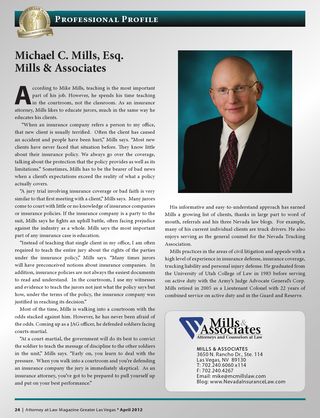Nevada courts regularly say that they favor adjudication of disputes on the merits of the claim and not some resolution based on a technical failure by a party or his/her attorney. See Young v. Johnny Ribeiro Building,.106 Nev. 88, 92, 787 P.2d 777 (1990). While there are a few exceptions to that general rule [click HERE], this policy of adjudication on the merits gives most claimants the opportunity to pursue almost any potentially viable cause of action all the way to trial. This adjudication on the merits policy has also thwarted many an attempt to shut down a somewhat questionable case based upon a technical discovery violation. However, the case of Moon v. McDonald, Carano & Wilson, LLP, 126 Nev. Adv. Op. 47, 245 P.3d 1138 (2010) raises the question whether the Court is softening it policy of adjudication on the merits or whether the court created an exception due to the particular facts.
This case involves Nevada’s Mandatory Court-Annexed Arbitration program.
For those of our readers
who aren’t familiar with this program, it provides for mandatory arbitration of most civil cases that have a value of $50,000 or less. See N.R.S. 38.250. There are obvious exceptions and Moon deals with a case that appears to have fallen through the crack between this arbitration program and the cases that are exempted from the program. Nevada’s Supreme Court Rules Governing Alternative Dispute Resolution put flesh to this program in the Nevada Arbitration Rule (N.A.R). The language of N.A.R. Rule 5(A) says that a case remains in the arbitration process until the Petition for Exemption is granted unless it is automatically exempt.
In Moon, Appellants filed a legal malpractice action against their former attorney and law firm on November 3, 2006. The case did not qualify for automatic exemption. Hoping to gain an exemption, Moon filed a Petition for Exemption from Arbitration claiming that the amount in controversy exceeded the $50,000 arbitration threshold. After the case was filed but before the Petition for Exemption from the program could be heard, the deadline set by the conventional discovery rules for non-arbitration cases, namely to hold an Early Case Conference and file a Joint Case Conference Report pursuant to Nevada Rule of Civil Procedure 16.1, came and went. Subsequently, the court granted the Petition for Exemption on March 29, 2007.
Thereafter, the law firm filed and prevailed on a motion to dismiss Appellant’s complaint arguing that Moon had failed to comply with the N.R.C.P. Rule 16.1 pretrial discovery rules.
On appeal to the Nevada Supreme Court, Moon argued that a case should be controlled by the arbitration rules until the matter is exempted. However, the Supreme Court pointed out that N.A.R. 4(C) provides that the Nevada Rules of Civil Procedure apply “[b]efore a case is submitted or ordered to the program, and after a request for trial de novo is filed”. The Supreme Court further cited to N.A.R. 4(C) which provides that the requirements of NRCP 16.1 cease to apply after a case is accepted or remanded into the arbitration program. The Supreme Court refuted the apparent inconsistency between N.A.R. 5 and the instant ruling, explaining that although N.A.R. 5 maintains the case is “subject” to the arbitration program immediately upon filing the initial pleading, the case is not actually “in” the program until an arbitrator is appointed.
The Supreme Court upheld the district court’s order dismissing the case. The Supreme Court said that the Nevada Rules of Civil Procedure, not the Nevada Arbitration Rules, govern cases awaiting exemption. Consequently, cases are subject to the requirements of N.R.C.P. 16.1 during the interim period and are subject to the sanction of dismissal for noncompliance.
The Supreme Court’s ruling clearly raises litigation management issues. In a perfect world, the Plaintiff’s request for exemption would be filed within 20 days of an answer and opposed, if such is the case, within 5 days thereafter, pursuant to N.A.R. 5(A) before obviating the need to even deal the obligations under N.R.C.P.’s 16.1 early case conference requirements. If, however, if the court delays a ruling on a Petition for Exemption, a party will have the obligation to comply with both sets of rules. (i.e. participation in an Early Case Conference and an Early Arbitration Conference as well as disclosures pursuant to both.) Nevertheless, this appears to be a small sacrifice in comparison to a possible dismissal of a complaint for non-compliance. When, and if, an arbitrator is appointed, the N.R.C.P. process then comes to an abrupt halt and the parties must shift gears to comply with N.A.R. One queries whether this is the most efficient process.
The Moon case involved a legal malpractice lawsuit by a client against its former attorneys, a law firm with a long Nevada heritage. The end-result was the ultimate sanction . . . dismissal of the lawsuit premised on the Moon’s failure to timely comply with mandatory pre-trial discovery requirements. The case presented an issue of first impression with procedural implications. And from a technical standpoint appears to be a correct interpretation. But what of the policy of adjudication on the merits? Has it been weakened? It remains to be seen whether the Moon holding will be enforced on a go forward basis or whether this was just an isolated incident based on these particular facts.
 Follow
Follow Email
Email


